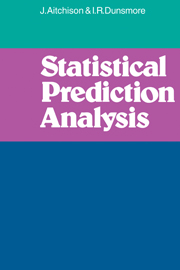Book contents
- Frontmatter
- Contents
- Preface
- 1 Introduction
- 2 Predictive distributions
- 3 Decisive prediction
- 4 Informative prediction
- 5 Mean coverage tolerance prediction
- 6 Guaranteed coverage tolerance prediction
- 7 Other approaches to prediction
- 8 Sampling inspection
- 9 Regulation and optimisation
- 10 Calibration
- 11 Diagnosis
- 12 Treatment allocation
- Appendix I
- Appendix II
- Bibliography
- Author index
- Subject index
- Example and problem index
1 - Introduction
Published online by Cambridge University Press: 12 October 2009
- Frontmatter
- Contents
- Preface
- 1 Introduction
- 2 Predictive distributions
- 3 Decisive prediction
- 4 Informative prediction
- 5 Mean coverage tolerance prediction
- 6 Guaranteed coverage tolerance prediction
- 7 Other approaches to prediction
- 8 Sampling inspection
- 9 Regulation and optimisation
- 10 Calibration
- 11 Diagnosis
- 12 Treatment allocation
- Appendix I
- Appendix II
- Bibliography
- Author index
- Subject index
- Example and problem index
Summary
The nature of statistical prediction analysis
An essential feature of statistical prediction analysis is that it involves two experiments e and f. From the information which we gain from a performance of e, the informative experiment, we wish to make some reasoned statement concerning the performance of f, the future experiment. In order that e should provide information on f there must be some link between these two experiments. Throughout this book we shall deal with problems where this link is through the indexing parameter of the two experiments e and f, and so we make the following assumption.
Assumption 1 The class of probability models which form the possible descriptions of e and the class of possible models for f have the same index set Θ, and the true models have the same (though unknown) index θ*.
A further general feature of all the problems we shall consider is contained in the following independence assumption.
Assumption 2 For given index θ the experiments e and f are independent.
By adopting this second assumption we deliberately exclude a range of prediction problems in which f is a continuation of some stochastic process of which e records a realisation to date. Techniques such as forecasting by exponential weighting, linear least squares prediction and time series analysis are thus outside the scope of this book.
To give some idea of the wide applicability of statistical prediction analysis as defined above and to motivate the development of appropriate theory we devote the remainder of this chapter to the presentation of specific prediction problems. All these problems are later analysed and extended in the sections indicated in the text.
Information
- Type
- Chapter
- Information
- Statistical Prediction Analysis , pp. 1 - 16Publisher: Cambridge University PressPrint publication year: 1975
